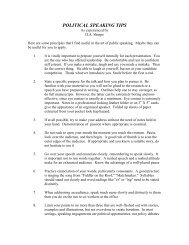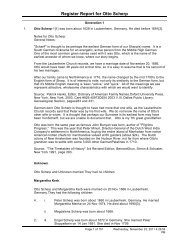Ahnentafel Report - D. A. Sharpe
Ahnentafel Report - D. A. Sharpe
Ahnentafel Report - D. A. Sharpe
Create successful ePaper yourself
Turn your PDF publications into a flip-book with our unique Google optimized e-Paper software.
<strong>Ahnentafel</strong> <strong>Report</strong> for Willis <strong>Sharpe</strong> Kilmer<br />
Generation 1<br />
representing him as the physician in charge of their medical department and also, that they<br />
pretended to give medical advice and prescribe medicines for diseases which they<br />
pretended to diagnose. When a lower court ruled against Dr. Kilmer and Company, Willis<br />
pursued the suit in The Appellate Court, and in 1917, the decision against the company<br />
was reversed. It was Willis <strong>Sharpe</strong> Kilmer's advertising prowess as well as his 'muscle' via<br />
political and professional contacts that made Swamp Root a household word. When other<br />
patent medicines were losing popularity, due to The Pure Food andDrug Act, as well as an<br />
increased respect for medical science, SwampRoot was still filling the Kilmer coffers. When<br />
asked what Swamp Root was good for, Willis Kilmer once replied, 'About a million dollars a<br />
year!'<br />
"Patent medicine wasn't the only thing Willis Sharp Kilmer was involved in. On April 11,<br />
1904, Mr. Kilmer founded The Binghamton Press, which became a very well-respected<br />
newspaper in the country. It has been alleged, although never proven, that he started the<br />
newspaper for the purpose of putting The Binghamton Evening Herald out of business and<br />
he could also control the advertising of various patent medicines and any articles<br />
condemning the same. There were several people such as Samuel Hopkins Adams, who<br />
were very much against patent medicines and were lobbying very hard for the passage of<br />
The Pure Food and Drug Act. Mr. Kilmer was very successful in 'squashing their stories and<br />
did eventually put The Evening Herald, run by his long-time personal and political enemy<br />
Guy Beardsley, out of business. Mr. Beardsley later sued Willis <strong>Sharpe</strong> Kilmer, charging<br />
conspiracy to put him out of business; Beardsley lost the suit.<br />
"Willis <strong>Sharpe</strong> Kilmer was also a very fine judge of horses. The family mansion is still located<br />
on Riverside Drive in Binghamton, and on the surrounding grounds, Mr. Kilmer built Sun<br />
Briar Court, which had a 1/5 mile indoor track, an outdoor track connected to a half-mile<br />
circular track, 100 fire-proof stalls, and the main stable included offices, quarters and a<br />
clubhouse. The Kilmer racing colors were brown, green and orange and he owned many<br />
fine horses; Genie, the son of Man O'War, Sun Briar, Sun Beau and Exterminator, which<br />
won the 1918 Kentucky Derby, and was the leading money winner for four straight seasons.<br />
SunBeau held the American record for money won until Sea Biscuit broke the record in<br />
1939. Mr. Kilmer owned a large estate on the Rappahannock River in Virginia known as<br />
Remlik (Kilmer spelled backwards) as well as a game preserve near Binghamton called Sky<br />
Lake. He was a pioneer in forest and game preservation in New York as well as in Virginia.<br />
He established the Kilmer Pathological Laboratory in Binghamton and started Binghamton's<br />
first nine-hole golf course, which later became the Binghamton Country Club.<br />
"Willis <strong>Sharpe</strong> Kilmer died of pneumonia on July 12, 1940, leaving an estate estimated at<br />
$10 to $15 million dollars, and is interred in the family mausoleum in Floral Park Cemetery in<br />
Binghamton, New York.<br />
"After World War II, his second wife, Sarah Jane Wells, sold the rights to make and<br />
manufacture Swamp Root to Medtech Laboratories of Cody, Wyoming. The six-story Kilmer<br />
Building, built in 1902 after the original building was damaged by fire, still stands at 141<br />
Chenango Street and Swamp Root was still on the shelves of the E. C. McKallor Drug<br />
Company in Binghamton in 1983. It can still be ordered today, more than almost 120 years<br />
after it was first produced, a testament to the advertising skill of Willis <strong>Sharpe</strong> Kilmer and the<br />
strength of the Kilmer name and reputation.<br />
About in 1914,<br />
Steven Palmatier loaned me a paper-bound book, well over 100 pages long, that used as<br />
the catalog for cautioning off the race horse stock of Willis' estate on October 30, 1940 at<br />
the Farm, Court Manor, near New Market, Virginia. The elaborate book gave the schedule<br />
for the day, including lunch, displayed an inventory of all the stallions, weanlings, and brood<br />
mares, had an individual page devoted for the genealogy and pedigree of each of the 102<br />
horses being sold, including photographs of a number of them, and a table showing the<br />
race winnings of Kilmer annually, totaling $3,919,519 for the previous 18 years. This, of<br />
Page 4 of 30 Wednesday, November 23, 2011 5:42:02<br />
PM














